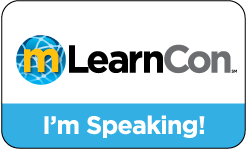As I was booking my travel to San Diego for the eLearning Guild’s mLearning conference, mLearnCon (June 15-17), I thought about a conference focusing on mobile learning versus the regular, full, elearning conference or even a full training conference (congrats to Training magazine pulling a phoenix). And I wondered how much this is a niche thing versus the whole deal.
 Now, I don’t think all of everything needs to be pulled through a mobile device, but the realization I had is that these devices are going to be increasingly ubiquitous, increasingly powerful, and consequently will be the go-to way individuals will augment their ability to work. Similarly, increasingly, workers will be mobile. Combining the two, it may be that support will be expected first on the personal device! While the nature of the way the device will be used will differ, desktops for long periods of time, mobile devices for short access, the way most ‘support’ of tasks will occur will be via mobile devices.
Now, I don’t think all of everything needs to be pulled through a mobile device, but the realization I had is that these devices are going to be increasingly ubiquitous, increasingly powerful, and consequently will be the go-to way individuals will augment their ability to work. Similarly, increasingly, workers will be mobile. Combining the two, it may be that support will be expected first on the personal device! While the nature of the way the device will be used will differ, desktops for long periods of time, mobile devices for short access, the way most ‘support’ of tasks will occur will be via mobile devices.
That is, people will use their mobile devices to contact colleagues, look for answers, access materials and tools ‘in the moment’. The benefits of desktops will be tools to do knowledge work, and there will be needs for information access, and colleague access, and collaboration, but increasingly we may want that when and where we want.
I’m thinking mobile could become the default target design, and desktop augments will be possible, versus the other way around. While you might want a desktop for big design work where screen real estate matters. For example, I’m designing diagrams on my iPad. I wouldn’t want to do it on my iPhone, but I am glad to take it with me in a smaller form-factor than a laptop. I may take back and polish on the laptop, but my new performance ecosystem is more distributed. And that’s the point.
Increasingly, we expect at least some access to our information wherever we are. (Yes, there are some folks who still eschew a mobile phone. There are people who still avoid a computer, or even electricity!) Mostly, however, we’re seeing people finding value in augmenting their capabilities digitally. And so, maybe we increasingly need to view augmentation as the baseline, and dedicated capability as the icing on the cake for specialized work.
This may be too much, but I hope you’re seeing that mobile is more than just a niche phenomenon. There are real opportunities on the table, and real benefits to be had. I’m surprised that it took so long, frankly, as I figured mobile was closer to ready-for-prime-time than virtual worlds. Now, however, while there are still compatibility problems, mobile really is ready to rock. Are you?


